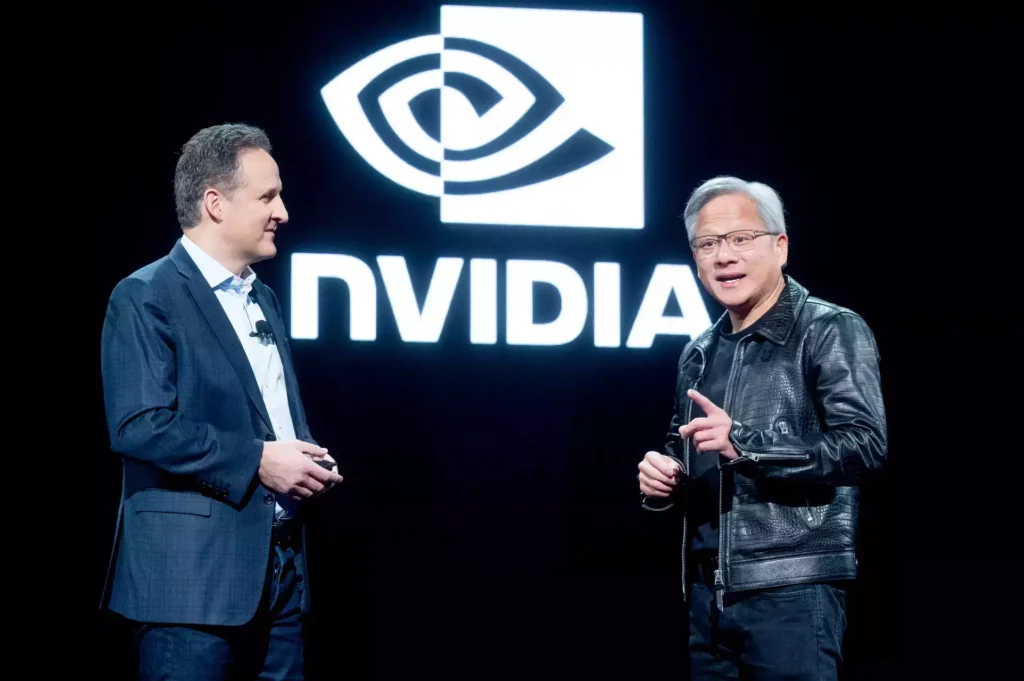How Nvidia Become the World Biggest Company?

Nvidia Corporation, founded in 1993 by Jensen Huang, Chris Malachowsky, and Curtis Priem, has risen to become one of the largest and most influential companies in the world, particularly within the technology and semiconductor industries. This rise to prominence can be attributed to a combination of innovative technology, strategic foresight, and the ability to capitalize on emerging trends in computing and artificial intelligence (AI). In this detailed exploration, we will delve into how Nvidia achieved its monumental success, the company’s primary aims, and its major clients.
Origins and Evolution
Nvidia started as a graphics card company, with its early products targeting the burgeoning video game industry. The company’s initial focus was on creating graphics processing units (GPUs) that could render high-quality visuals, which were becoming increasingly important for video games. The launch of the GeForce 256 in 1999, often considered the first GPU, marked a significant milestone. This product not only boosted Nvidia’s profile but also set a new standard for the graphics industry.
The company’s trajectory changed profoundly in the early 2000s as it began to explore the potential of GPUs beyond gaming. Nvidia realized that the parallel processing capabilities of GPUs could be harnessed for a variety of computing tasks, particularly those involving large-scale data processing and complex calculations.
Strategic Vision and Expansion
Nvidia’s strategic vision extended beyond gaming into professional visualization, high-performance computing (HPC), and eventually AI and machine learning. The introduction of the CUDA (Compute Unified Device Architecture) platform in 2006 was a game-changer. CUDA allowed developers to use Nvidia GPUs for general-purpose computing, enabling significant performance improvements in scientific research, financial modeling, and various forms of data analysis.
The company’s investment in AI and deep learning became a pivotal focus. Nvidia GPUs proved to be exceptionally well-suited for training deep neural networks due to their parallel processing capabilities. This realization led Nvidia to actively court the AI research community and form partnerships with leading tech companies and academic institutions.
Dominance in AI and Data Centers
Nvidia’s focus on AI and data center markets paid off handsomely. The company’s GPUs became the de facto standard for training AI models, which are computationally intensive processes that benefit immensely from the parallelism offered by GPUs. Nvidia’s GPUs power many of the world’s fastest supercomputers and are integral to the infrastructure of leading tech companies like Google, Amazon, and Microsoft.
The launch of the Nvidia Volta architecture in 2017, with its Tensor Cores specifically designed for deep learning, further solidified the company’s leadership in AI.
Acquisition Strategy
Nvidia’s growth has also been fueled by strategic acquisitions. Notable acquisitions include Mellanox Technologies, a leader in high-performance networking, which helped Nvidia enhance its data center offerings. The acquisition of ARM Holdings, announced in 2020, was another bold move aimed at expanding Nvidia’s influence in the mobile and embedded systems markets, though this deal faced regulatory challenges.
Main Aim of Nvidia
Nvidia’s overarching aim is to advance computing technology to address complex challenges and enable new possibilities across various domains. The company envisions a future where AI and accelerated computing are central to technological progress.
- AI and Machine Learning: Nvidia aims to be at the forefront of AI innovation, providing the hardware and software tools necessary for researchers and developers to push the boundaries of what AI can achieve.
- Gaming and Entertainment: While Nvidia has expanded its horizons, it remains committed to its roots in gaming. The company continually strives to develop cutting-edge GPUs that deliver unparalleled gaming experiences.
- Data Centers and Cloud Computing: Nvidia seeks to transform data centers with its GPUs, enabling more efficient and powerful computing environments that can handle the growing demands of modern applications, from AI to high-performance computing.
- Autonomous Vehicles: Nvidia is heavily invested in the development of autonomous driving technology. Its DRIVE platform provides the computational horsepower and software necessary for self-driving cars, aiming to make transportation safer and more efficient.
- Professional Visualization: Nvidia’s GPUs are used in various professional fields, including medical imaging, architecture, and product design, where high-quality visualization is crucial.
Major Clients and Partnerships
Nvidia’s impressive client list spans numerous industries and includes some of the most influential companies in the world. Here are some of the key sectors and notable clients:
- Tech Giants and Cloud Providers: Nvidia’s GPUs are integral to the infrastructure of leading cloud service providers such as Amazon Web Services (AWS), Google Cloud Platform (GCP), and Microsoft Azure. These companies use Nvidia GPUs to offer GPU-accelerated services to their customers, enabling applications in AI, machine learning, and data analytics.
- Automotive Industry: Nvidia partners with major automotive manufacturers like Tesla, Toyota, and Mercedes-Benz to develop autonomous driving technologies. Tesla, for example, uses Nvidia’s hardware for its self-driving software, while other manufacturers rely on the Nvidia DRIVE platform for developing and testing autonomous vehicles.
- Healthcare and Life Sciences: In the healthcare sector, companies use Nvidia’s GPUs for applications ranging from medical imaging to genomics. Companies like Siemens Healthineers and GE Healthcare utilize Nvidia technology to enhance diagnostic imaging and improve patient outcomes.
- Financial Services: Financial institutions leverage Nvidia’s GPUs for high-frequency trading, risk management, and fraud detection. Firms like J.P. Morgan and Citadel use GPU-accelerated computing to gain competitive advantages in their trading operations.
- Entertainment and Media: Nvidia’s technology is also pivotal in the media and entertainment industry. Studios like Pixar and Industrial Light & Magic (ILM) use Nvidia GPUs for rendering special effects and animation. The ability to render complex scenes quickly and accurately is crucial for producing high-quality visual content.
- Scientific Research and Academia: Nvidia collaborates with numerous universities and research institutions. The Summit supercomputer at Oak Ridge National Laboratory, one of the fastest in the world, uses Nvidia GPUs to perform cutting-edge scientific research.
Key Products and Technologies
Nvidia’s success is also rooted in its extensive portfolio of products and technologies, each designed to cater to the needs of different market segments:
- GeForce GPUs: Nvidia targets gamers and consumers seeking high-performance graphics with its GeForce line. These GPUs deliver stunning visuals and smooth gameplay experiences.
- Quadro and RTX: Nvidia rebranded the Quadro series as RTX, targeting professionals in fields such as animation, design, and visualization. These GPUs offer powerful capabilities for rendering, simulation, and AI workloads.
- Tesla and A100 GPUs: Designed for data centers and AI applications, Tesla and A100 GPUs provide the computational power required for training and deploying large-scale AI models. These GPUs are integral to the operation of modern AI systems.
- Jetson: Nvidia focuses its Jetson platform on edge computing and robotics. It provides the processing power needed for autonomous machines, drones, and other devices that require AI capabilities at the edge of the network.
- DGX Systems: Nvidia DGX systems are purpose-built for AI and deep learning. These integrated solutions offer researchers and enterprises the tools necessary to accelerate AI development and deployment.
- Nvidia Omniverse: Omniverse is a platform for real-time collaboration and simulation. It enables professionals in various fields to work together in a shared virtual space, making it easier to design, simulate, and visualize complex projects.
Challenges and Future Prospects
Despite its success, Nvidia faces several challenges and uncertainties. The semiconductor industry is highly competitive, with rivals like AMD and Intel continuously developing new technologies. Regulatory scrutiny, particularly regarding acquisitions like ARM, also poses potential obstacles.
However, Nvidia’s future prospects remain bright. The company’s leadership in AI and deep learning positions it well to capitalize on the growing demand for these technologies.
Conclusion
Nvidia’s journey from a niche graphics card company to a global leader in AI and computing technolog. And is a testament to its visionary leadership, strategic foresight, and relentless innovation. By recognizing the potential of GPUs beyond gaming and investing heavily in AI. Nvidia has positioned itself at the forefront of multiple technological revolutions. The company’s primary aim of advancing computing technology to solve complex problems.Nvidia’s ongoing innovations in computing will likely further expand its impact on the technology landscape.





